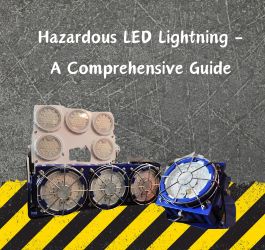Cable glands play a crucial role in ensuring the optimal functioning of electronic systems operating in challenging industrial environments. Investing in quality cable glands and cable protection products becomes essential for safeguarding critical electrical equipment and cable fittings against the elements.
While not every industrial application necessitates the use of cable glands, they prove invaluable in scenarios where systems face exceptional stress regularly. The presence of plastic or metal cable glands can make a significant difference, helping to prevent breakdowns, minimize downtime, and mitigate associated costs.
In the following discussion, we will delve into the common applications of various types of cable glands, shedding light on their widespread use in industrial settings and outlining the key advantages they offer to these sectors.
What Is A Cable Gland?

Cable glands serve as mechanical devices designed for cable entry in electrical, instrumentation, control, and automation systems. They are essential components used in conjunction with cables and wiring, facilitating the management of various systems, including lighting, power, data, and telecommunications.
A diverse range of cable glands, encompassing both metal and plastic variants, is tailored to fulfill various functions. Their primary purpose is to prevent unintended dislodging, unscrewing, or displacement of cables, offering protection against environmental elements such as dust, dirt, water, moisture, chemicals, and extreme temperatures.
The Role of Cable Glands

These robust sealing and termination devices find extensive use in various applications, including:
Outdoor Cable Protection
Safeguarding electrical cables laid outdoors, providing crucial environmental protection against rain and adverse weather conditions.
Offshore Applications
Protecting electrical equipment and cables in offshore settings, where regular exposure to water is anticipated.
Hazardous Environments
Deployed in extreme industrial conditions with a risk of explosive or hazardous environments.
Dusty Industrial Settings
Applied in industrial environments generating substantial dust, ensuring electrical equipment remains shielded.
Chemical Exposure Protection
Shielding unprotected or unarmoured cables from exposure to dangerous or corrosive chemicals.
Passing Cabling Through Barriers
Facilitating the passage of cabling through plating and bulkheads, ensuring secure and protected cable entry.
If your application is exposed to any of these risks or necessitates specific requirements, careful consideration of various cable gland types is crucial to ensure optimal security and protection.
For instance, the need for waterproof cable glands arises to counter water ingress, while the choice of metal cable glands crafted from materials like brass, aluminum, or steel ensures robust performance.
Additionally, a range of plastic and rubber protection systems is available. The selection of the appropriate cable gland hinges on the unique environmental conditions in which your business functions.
When Should Cable Glands Be Utilized?
The advantages of cable glands are widely acknowledged in industries where exposure to environmental elements poses a risk to electrical cables and equipment. This encompasses various sectors such as aerospace, manufacturing, marine, power and utilities, telecommunications, transportation, and food and beverage.
These industries routinely employ both standard cable glands and armored cable glands to safeguard their essential electrical infrastructure from moisture, dirt, dust, and other contaminants.
If you're contemplating the suitability of a cable gland for safeguarding your electrical connections, consider the following inquiries:
- Is your electrical equipment situated indoors or outdoors? Is there a possibility that a cable entry point could be exposed to rain, nearby water, or other environmental sources of contamination?
- Does your configuration necessitate an electrical cable or power system to function reliably in an explosive or hazardous environment, requiring additional environmental sealing?
- Could your electrical instrumentation be susceptible to dust or moisture without a dedicated sealing and termination device for protection?
- What is the temperature at the operational site? Is it consistently maintained, or could your electrical equipment be at risk of damage due to excessive heat or cold?
- Are you managing automation systems that need to operate for extended periods without manual maintenance or cleaning?
Types of Cable Glands

There are four primary types of cable gland:
| Single Compression | | Double Compression | Flexible Hose | PVC | |
Both single and double-compression cable glands are further categorized into THREE types:
- Light Duty
- Weatherproof
- Flameproof
Threading, the mechanical grooves applied to the nuts or attachments, also varies from gland to gland. Look for the following standards, each serving different purposes:
| ISO Metric Thread | A widely used international standard for screw threading |
| National Pipe Thread | US standard employed for threaded pipes and pipe fittings |
Armoured Cable Glands
An armoured cable gland, also referred to as a cable connector or fitting, serves a vital role in terminating and securing cable ends across diverse applications. Designed to attach cables to equipment or enclosures, these glands offer a secure seal to prevent the ingress of dust, moisture, or other contaminants that could jeopardize the electrical system's integrity.
Furthermore, cable glands safeguard cables from tension and twisting, ensuring their stable positioning and reliable performance.
Waterproof Cable Glands
Waterproof cable glands typically feature an IP68 waterproof rating, indicating their capability to withstand immersion in water at depths of one meter or more, in accordance with the International Protection (IP) standard.
Functioning as essential components for facilitating cable connections within electrical enclosures, waterproof cable glands are designed to uphold a watertight seal at the entry point of cables into the enclosure.
These glands commonly consist of a nut and a body, with the option of including a separate gasket or cable seal, or integrating these elements within the gland body itself. Installation entails placing the gland into a circular cutout within the enclosure, securing the enclosure wall between the nut and body to establish the desired watertight seal.
Waterproof cable glands are available in a variety of types, materials, and sizes, offering versatility to accommodate diverse applications and specifications. The IP standard serves as a universally acknowledged benchmark for assessing a product's resistance to water, dust, and other forms of contamination.
Metal Cable Glands
Crafted from materials such as stainless steel, aluminum, and brass, metal cable glands offer various advantages:
| Material | Characteristic | Common Application | ||||||
|---|---|---|---|---|---|---|---|---|
| Stainless steel | | Various industrial settings, especially where corrosion is a concern | Aluminum | Widely used in electrical applications, construction, and industrial settings | Brass | Construction industry, industrial applications | |
There are SIX types of brass cable glands available:
| Type | Characteristic | Common Application |
|---|---|---|
| Indoor | Versatile design for various cable types, including armoured, plastic, and rubber-sheathed | Suitable for a range of indoor cable installations |
| Outdoor | Compatible with both plastic or rubber-sheathed and unsheathed cables | Used in outdoor cable installations |
| Straightening | Used with both rubber-sheathed and unsheathed cables, applicable indoors and outdoors | Helps straighten and secure cables in various settings |
| Weatherproof | Robust design for plastic or rubber-sheathed cables, prioritizing strength and a secure seal | Provides strong protection, with a specialized variation for maximum water resistance |
| Threaded | Custom-made glands tailored for specific industrial applications | Designed for unique industrial cable requirements |
| Industrial | Primarily used with plastic or rubber-sheathed and armoured cabling | Common in industrial settings for various cable types |
| Rubber Cable Glands | Utilizes watertight seals made from synthetic rubber, including Chloroprene for O-rings and Neoprene for washers | Enhances cable sealing, preventing water ingress |
Cable Glands For Specific Applications

There are distinct categories of cable glands designed to cater to specific applications. The primary application-specific cable gland types include:
Electromagnetic Compatibility (EMC) Cable Glands
EMC glands serve to protect both cables and machinery from electromagnetic interference (EMI) that could compromise the functionality of electrical equipment. By acting as a barrier against EMI at the termination point, these glands find common use in telecommunications applications and scenarios where EMI could disrupt machinery.
Marine Cable Glands
Marine cable glands are essential components utilized across a range of industries operating in challenging marine environments, including shipbuilding, offshore oil and gas, and maritime construction.
Moreover, marine cable glands also serve a vital role in safeguarding equipment and marine cables within hazardous zones such as ship engine rooms, offshore oil platforms, chemical plants, and petrochemical industries.
Additionally, marine cable glands play a crucial role in subsea installations, ensuring the protection and effective communication of underwater cables with offshore platforms.
These cable glands establish a watertight seal at the termination point, ensuring a secure connection when cables are connected to enclosures. They are commonly employed in various applications, including wastewater treatment facilities, where components connect on both sides of the enclosure during assembly.
Electric Cable Glands
Electric cable glands, metallic in nature, incorporate an earthing clamp or tag. This earthing component plays a crucial role in preventing electrocution by redirecting electrical current to the ground through the wire. Additionally, it safeguards the connection in the event of a short circuit.
Fire-Stop Cable Glands
Designed to resist fires and explosions, fire-stop cable glands play a vital role in curbing the spread of fire and smoke. These glands not only maintain the electrical connection but also allow the machine to continue operation if necessary.
Widely utilized in the rail industry, fire-stop glands contribute to passenger, personnel, and cargo safety on trains by preventing the spread of fire and smoke while ensuring the train can operate until reaching a secure area.
Cable Gland Designations
Cable glands are frequently assigned specific designations in accordance with BS 6121. Originally devised for standardizing cable strain reliefs in the industrial sector, this British Standard outlined requirements for various designs.
While it may no longer be the latest standard in the EU, it retains significance among manufacturers as a means to communicate types of glands and their essential features. Among the most prevalent types and designations are:
Type A Cable Glands
Type A cable glands, sometimes known as "stuffing glands," are commonly employed for unarmored plastic or rubber-sheathed cables. This category includes four designations:
These A-type glands find applications in both indoor and outdoor settings where armored cables are unnecessary.
Type B Cable Glands
Type B cable glands are specifically crafted for single-wire armored cables with plastic or rubber sheaths. Composed of brass, these glands secure the cable's armor and establish an electrical path between the armor and the gland. They are designed for indoor applications with minimal exposure to moisture.
Type C Cable Glands
Type C cable glands are intended for use with plastic or rubber-sheathed cables featuring armor or braiding. Constructed from brass or stainless steel, type C glands serve a similar purpose as their type B counterparts. The key distinction lies in the type C cord grip, which incorporates an IP68-rated seal between the outer sheath and the gland.
This additional seal enhances protection against moisture and environmental exposure, making type C connectors suitable for outdoor applications demanding greater weatherproofing and waterproofing.
Type D Cable Glands
Type D cable glands, akin to type B, are tailored for use on armored or wire-braided cables with plastic or rubber outer sheaths. The key distinction lies in the inclusion of an IP68-rated seal between the inner sheath and the threaded fixing part.
Two variations of the type D cable gland exist:
Type E Cable Glands
Type E cable glands find application in cables with armor or braiding and plastic or rubber outer sheaths. Typically crafted from brass or stainless steel, the type E cord grip resembles the C-type design, featuring an armor locking ring and IP68-rated inner and outer seals. The outer seal secures the cable sheath, while the inner seal grasps the cable's bedding layer.
TWO variations of the type E cable gland are available:
Type E cable glands excel in applications exposed to the elements, providing robust waterproofing and weatherproofing through the seal features of the E variation.
BS 6121 Suffixes
Alongside the B, C, D, and E classifications, cable glands often carry a suffix indicating their specific armoring compatibility. These suffixes are elucidated as follows:
| W | Suitable for single wire armored cables |
| T | Designed for pliable wire armored cables |
| X | Tailored for wire braided cables |
| Y | Compatible with aluminum strip armored cables |
| Z | Geared for double steel tape armored cables |
In application, the cable gland is denoted first with its cable type and immediately followed by the indication of its protection suitability. For instance, a type C cord grip crafted for single wire armored cables will bear the designation "CW."
In cases where a gland design accommodates multiple armoring variations, all relevant suffixes are appended after the cable gland type. For example, a type B cable connector engineered for both single and pliable wire armored cables will be labeled "BWT".
How To Choose Cable Glands?
Navigating the myriad features and designs of cable connectors can be daunting, making it crucial to pinpoint the right cable gland for a specific application. The key lies in first understanding the application's requirements and then systematically eliminating unsuitable cable fitting options.
When selecting a cord grip, consider the following essential questions:
Once you've narrowed down the cable gland options that align with your application's needs, the final decision can be based on cost considerations.
Where Can I Get Cable Glands?
Cable glands may be small, but their significance resonates across diverse industries such as aerospace, marine, power, telecom, and the industrial sector. Serving as a crucial safety component, these cable fittings play a vital role in various applications.
To ensure optimal performance and alignment with your specific environment, it's imperative to invest in high-quality designs. You can find the perfect cable glands that are tailored to your needs through here .
Conclusion
When choosing a cable gland for your specific needs, consider factors like the type of cable, the environment it will be in, and the materials used. Proper installation and regular maintenance are key for ensuring electrical systems last long and work efficiently. Investing in high-quality cable glands is crucial for safety and success in various industries, whether it's on an oil rig, mining site, renewable energy project, or any other industrial setting.










